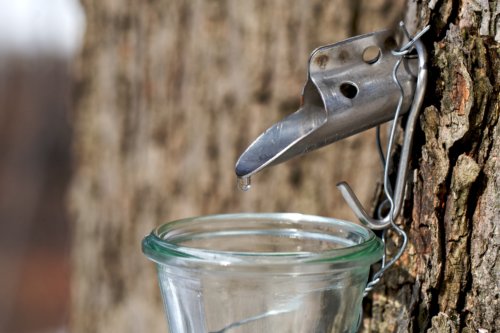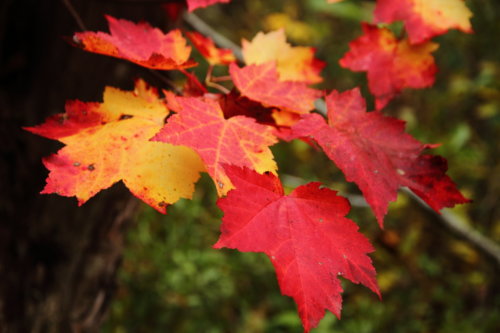Understanding The Cultural Significance of The Great Canadian Maple
The sight was a familiar one that, somehow, never lost its magic. At summer’s end, I’d gaze out the window at a scene more beautiful than a painting: brightly colored maple leaves swaying on their branches. The wind tousled softly through leaves of red, gold, and amber, as if to usher me outside to discover what wonders the fall had in store.
In the bitter cold of winter, I’d behold the snow-dusted maples once again, their sugary gifts but a drip of what would soon pour abundantly from their trunks. Soon, in the short window between winter and spring, the “sugaring” would be upon us, and the spiles that we carefully tapped into the bark of the maples would flow with golden sap. Whether it’s poured onto flapjacks or stirred into tea, there’s nothing quite like pure Canadian maple syrup. Today, we explore the history of maple syrup in the True North and finish with a sweet recipe that’s sure to make your taste buds dance like a Canadian skating on a frozen pond.
26,500,000 Liters of “Liquid Gold”
The maple tree holds a special place in the heart of this Canuck. Not only is its leaf our national emblem, but the maple tree is so rooted in my early memories of rural Ontario. But there’s a reason that maple syrup is so prototypically Canadian: 80 percent of the world’s maple syrup originates in Canada, coming mostly from Quebec– a province with more than 7,000 producers. In 2004 alone, Canada produced a whopping 26,500,000 liters of pure maple syrup.
Aboriginal folklore and archaeological evidence suggest that the First Nations people of Canada brought maple syrup production into the mainstream. According to the Canadian Encyclopedia, Historica Canada, the indigenous peoples of eastern North America were producing maple syrup long before the arrival of European settlers.
80 percent of the world’s maple syrup originates in Canada, coming mostly from Quebec– a province with more than 7,000 producers.
“An Iroquois legend tells of the piercing of the bark of a maple and the use of the ‘sweet water’ to cook venison,” Historica Canada reads. “This was a happy accident, which established the culinary tradition of maple-cured meats.”
It’s widely believed that the First Nations people shared their knowledge of maple syrup production with early French settlers, who would eventually modernized the practice with more advanced machinery. This might explain why Quebec, a province with a French-speaking majority, is such a big player in the production of Canadian maple syrup.
The Sugar Moon
As the snow melted and spring inched closer, the First Nations people would leave their hunting grounds and “set up camp in a sugar bush,” Historica Canada notes. “The men cut notches into the tree trunks, and small hand-carved wooden troughs were stuck into the bark.”
A wooden bowl was placed below the maples to catch the sap that dripped down the trough. When the bowls were full, each family would carry the sap to the “sugar hut” for the next stage of syrup-making. The sap was then boiled into syrup using hot rocks.
The First Nations people, who saw maple syrup as a source of energy and nutrition, would celebrate the “sugaring off” with a Maple Dance. This ceremonial dance signified the “Sugar Moon”, which is the first full moon of spring.
Often imitated but never duplicated, pure maple syrup adds a beautiful flavor to entrees, desserts, and appetizers.
Maple Syrup & Pecan Steamed Puddings
Sweeten up any occasion with Jamie Oliver’s Maple Syrup & Pecan Steamed Puddings! These delicious bite-sized puddings will have you coming back for seconds. Bon appétit!
Ingredients
- Butter (for greasing)
- 1/2 cup pecans (or different nuts, if you prefer)
- 3/4 cup plain flour (sifted)
- 1/4 cup brown sugar
- 2/3 cup vegetable suet
- 1 teaspoon baking soda
- 1 large egg
- 8 tablespoons maple syrup
- 1 vanilla pod (with seeds removed)
- 1/2 cup whole milk
- Cream or custard (to serve)
Method
- Preheat the oven to 375°
- Grease six small teacups with butter. (Small ceramic bowls will also work, in a pinch.)
- Place the pecans in a sandwich bag. Close the bag and crush the pecans with a rolling pin.
- Sprinkle the insides of the teacups with the crushed pecans, and tip the excess into a large bowl.
- Add all remaining ingredients into the bowl and mix well.
- Pour a tablespoon of maple syrup into the bottom of each teacup, and pour some of the mixture on top. (The cups should be about three-quarters full.)
- Place the cups in a deep, large roasting tray. Pour boiling water into the tray (around the cups) until the water is about halfway up the side of the cups.
- Carefully place the tray in the oven and bake for about 25 minutes until the cakes are golden on top and cooked through.
- Let stand to cool for a few minutes. Serve the cakes in the teacups or turn them out and plate them on a small saucer.
- Serve with custard or cream and an extra drizzle of warm maple syrup on top. Enjoy!





































